1. Gobi Desert - the Singing Dunes (Khongoryn Els) and Flaming Cliffs
The Gobi desert is 1,295,000 square kilometres and is the fifth largest desert in the world and the biggest in Asia. Much of the Gobi is not sandy but is covered with bare rock.
The Khongoryn Els Sand Dunes are some of the largest and most impressive sand dunes in Mongolia. Also known as the Duut Mankhan or Singing Dunes this natural wonder stretches for more than 180 kilometres with some dunes reaching heights of 300 metres. The largest dunes are in the north western part of the range. Climbing to the top allows tourists to hear the eerie singing the dunes are named for. Views of the surrounding desert are awe inspiring; an opportune time to climb is just before sunset to witness the giant red orb gently sink into the horizon. Sliding down the sand hills is fun way to finish a trip to the dunes. They are also perfect for camel riding with many camels available and spending the night in one of the plentiful camping spots or ger camps allows more time to explore.
The Flaming Cliffs site, also known as Bayanzag, sometimes Bain-Dzak,[1] (Mongolian: rich in saxaul), with the alternative Mongolian name of Mongolian: (red cliffs), is a region of the Gobi Desert in the Southgobi Province of Mongolia, in which important fossil finds have been made. It was given this name by American paleontologist Roy Chapman Andrews, who visited in the 1920s. The area is most famous for yielding the first discovery of dinosaur eggs. Other finds in the area include specimens of Velociraptor [2] and eutherian mammals. It is illegal here to remove fossils without appropriate permits.
The red or orange color of the sandstone cliffs (especially at a sunset), hence the nickname.

2. The cave of Tsenkher, Khovd aimag
This cave is located in Mankhan soum, on the banks of the Tsenkher River, about 100 kilometres southeast of Khovd city. The cave is about 20 metres high and was inhabited about 15,000 years ago in the Paleolithic Era.



3. Historical monuments in the Orkhon valley, Arkhangai aimag
The Orkhon Valley Cultural Landscape was inscribed by UNESCO in the World Heritage List as representing the evolution of nomadic pastoral traditions spanning more than two millennia.
Examples of such sites in the valley include two early 8th century memorials, the most impressive monuments from the nomadic Turkic pre-Mongol empire. The monuments, located in the same region as Karakorum, Ghengis Khaan’s ancient capital, were excavated and deciphered by Russian archaeologists in 1889-93. The 3 metre high inscribed monument of Kul-Tegin (684-731) was the ruler of the ancient empire. Raised in AD 732 the inscription is in Runic and Chinese Script.
Bilge Khagan monument, about 1 kilometre away, dates back to AD 683-734. Bilge Khaga was Kul-Tegin’s older brother. These monuments constitute all that remains of the Turkish Khanate in modern day Mongolia. The monuments are adorned from top to bottom with inscriptions by Tonyukuk who acted as advisor to the Turkish Khans.
Another 20 km away, on the banks of the Orkhon Gol, are the ruins of Khar Balgas, the 8th century capital of the Uighur Empire, which ruled Mongolia from 744 to 840. The ruins cover 50 km2 and contain evidence of a palace, outer walls, shops, temples, monasteries and Buddhist Stupas. From the walls you can see the remains of irrigated fields. The city also had a complex plumbing system that piped water in from the nearby river.
Tuvkhun Hermitage is a spectacular monastery overlooking a hill at 2,600 metres. It was almost completely destroyed by the Stalinist purges of the late 1930’s, but has been restored in recent years.



4. Hunnu state tombs in Noyon Mountain, Tuv aimag
Noyon Mountain is the most famous archaeological site in Mongolia with its series of Hunnu tombs. Archaeological research has determined that Mongolian ancestors were Hun people. Hun actually means person in Mongolian. The Noyon Mountain archaeological site was first identified in 1912 and first seriously excavated in 1924 under the supervision of S. A. Kondratev and S. A. Teploukhov, who were part of the Tibeto-Mongolian expedition led by famous Russian explorer Pyotr Kuzmich Kozlov. The first excavation retrieved a wide range of organic materials, which had been preserved in tombs. The tombs enshrined Hunnu elite, encased in wooden chambers hung with textiles. A Chinese lacquerware cup dating to the 4th century provided a terminus post quem for one of the graves. Findings such unique artefacts was an important event in the history of Mongolian archaeology. Excavations resumed in the mid-1950s by a Mongolian led team including Kh. Perlee and Ts. Dorjsuren. A joint project involving the well-known Siberian archaeologist Natalya Polosmak has continued at Noyon Mountain in recent years. A selection of the Noyon Mountain finds can be viewed today in the Hermitage Museum in St. Petersburg and in the National Museum of Mongolia in Ulaanbaatar.


5. Erdene Zuu monastery and Zanabazar’s masterpiece, Kharakhorum
Erdene Zuu – meaning Hundred Treasures – was the first Buddhist monastery established in Mongolia it is considered one of the most important monasteries in the country.
Construction of the monastery began in 1586 and wasn’t finished until 300 years later. As the monastery is adjacent to the ancient capital Karakorum, buildings were made from stone salvaged from the city ruins. Between 60-100 temples were once located inside its walls along with 300 gers, but the Stalinist purges in 1937 destroyed many of them and left only 18 untouched. Roughly 1000 monks resided at the monastery. Thankfully a surprising number of statues, tsam masks and thangkas were saved and buried in nearby mountains or stored at local homes.
Reopened as a museum in 1965 it resumed monastic worship only in 1990 when religious freedom was restored after the collapse of communism. The surviving temples give a good impression of the layout of the original with all temples intact, with some restoration undertaken. The surrounding wall is also intact and is dotted with 100 small stupas. Inside the walls Buddhist monks can be observed partaking in their daily activities.

6. Khuvsgul lake
Known as the Blue Pearl of Mongolia, Lake Khuvsgul is Mongolia’s deepest lake, at a depth of 262 metres, and is the second largest at 2760 square kilometres. Located in the northernmost province, its crystal clear waters feed into Lake Baikal in Russia and it’s the second largest fresh water lake in Central Asia. It is also the world’s 14th-largest source of fresh water, containing around 2 percent of the world’s fresh water or 380,700 billion litres.
The lake is part of the protected Khuvsgul Nuur National Park bordered by mountains covered with Siberian larches that turn gold in the fall. The small town of Hatgol borders its southern shore and is a popular tourist destination with many places to stay both in town and next to the lake.
Located at an altitude of 1645 metres above sea level it freezes over from January until April or May revealing fantastic lacy ice patterns. It’s when the huge lake is frozen solid, to 3 metres deep, that Khuvsgul’s most well-known event takes place. At the end of February the two day Ice Festival is held on the lake with locals and tourists partaking. Events include a gala opening ceremony on the ice, a folklore concert, shaman ceremony and many competitions featuring ice sculptures, ice sumo wrestling, ankle bone shooting, plus horse, reindeer sled, jeep and ice skating races, a tug-o-war and other games. Winter sports include downhill and cross-country skiing, ice-fishing contests, a 100 kilometre ice-skating marathon (around a 6km circuit) and a 12 kilometre horse sleigh race. Khuvsgul is surrounded by a Taiga forest, and the lake itself is an important ecological site; home to a variety of mammals, including elk, reindeer, brown bear, Iynx, beaver, wolf, and moose.
The lake also supports 76 species of fish including the Siberian grayling and lenok. A ferryboat operates in summer and is left to freeze in the lake over winter. Lake Khuvsgul is on a migration route for birds from Siberia, allowing for bird-watching opportunities. Hiking, horse treks, and kayaking are also popular activities.

7. Chinggis Khaan Statue Complex and 13th Century National Camp
The Genghis Khan Statue complex is located 54 kilometres from Ulaanbaatar, the capital of Mongolia, on the bank of the Tuul River, in a place called Tsonjin Boldog. It was here, according to legend, that Genghis Khan found a golden whip.
The complex was designed by sculptor D. Erdembileg and architect J. Enkhjargal. A 40 metre high statue of Genghis Khan on horseback was erected on a 10 metre high base, covered by stainless steel and surrounded by 36 columns. These columns represent the 36 kings’ descended from Genghis down to Ligdan Khan.
A recreation area, restaurants, souvenir shop and conference hall occupy the base structure. From here, visitors can ascend to the exhibition hall using an elevator at the back of the horse. Walking out of the statue a panoramic view of the surrounding steppe can be taken in. It is planned the area will contain 200 yurt camps, designed and arranged in the pattern of the horse brand marks that were used by the 13th century Mongol tribes. The cost of the complex is reported to be $4.1 million.
The 13th century living museum shows the authentic lifestyle of Mongols who lived during the ruling of Ghengis Khan. It features warriors in traditional costumes and armour. Visitors can enjoy visit local herder families, try camel and horseback riding, and traditional games of ankle bone shooting.

8. Uvs lake and area
Since 1997, the Uvs-Nuur-Basin is recognised as UNESCO biosphere reserve. And it became protected area of Mongolia in 1993.
Situated near the north western frontier of Uvs Aimag this region is a mixed desert zone forming an ecologically distinctive area. Lake Uvs is the largest salt lake in Mongolia and the lowest area of the Great Lakes region at an altitude of just 759 m. The lake has a surface area of 3350 square kilometres, is 84 kilometres in length, 79 kilometres wide and ranges from 10 to 20 metres deep. The lake is five times saltier than the ocean, even though 38 fresh water rivers flow into the lake, and is devoid of edible fish. Reeds, broom grass, scrub, wicker and poplar grow along the shoreline. Many migrant birds including swans, snowy egrets, spoonbills, sand-grouse, goose and yellow ducks gather at the lake.
In the desert and mountains surrounding the lake rare animals like marmots, polar cats, the threatened snow leopard, wild sheep and the Asiatic ibex can be glimpsed. Around Uvs Lake more than 220 bird species have been recorded.

9. Burkhan Khaldun mountain
This remote mountain lies in the Khan Khentii Strictly Protected Area established in 1992, a region comprising 1.2 million hectares. Meaning God’s Hill, it was proclaimed a sacred site by Genghis Khan and is therefore considered the most sacred mountain in Mongolia. It’s rich in archaeological history with over 800 identified burial site. It’s also thought the great khan’s own tomb is somewhere on the mountain but it has never been found.
The Burhan Haldun is in the Khentii Mountain Range in the Khentii Province of Mongolia. The mountain itself and the surrounding area are rumored to be the birthplace of Genghis Khan, as well as the purported location of his tomb.
Due to its auspicious nature many Mongolians climb the mountain, which is topped with a sacred ovoo, for good luck.
Prior to Genghis Khan’s time there was a strong religious significance attached to the mountain.



 Naranchuluun
Naranchuluun 